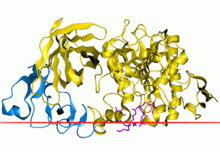
Back إنزيمات البنكرياس (دواء) Arabic Mədəaltı vəzi fermentləri AZ Pancrelipasa Spanish Enzymes pancréatiques (médicament) French Pankreatin Croatian ଅଗ୍ନାଶୟ ଏଞ୍ଜାଇମ (ଡାକ୍ତରୀ ବ୍ୟବହାର) OR Enzimas pancreáticas (medicação) Portuguese Pankrelipaza SH Pankrelipaza Serbian பேங்கிரியாட்டின் Tamil
This article is missing information about Lactase supplement. Why is lactase not included?. (January 2024) |
 Complex of lipase with colipase | |
| Clinical data | |
|---|---|
| Trade names | Creon, Pancreaze, Pertzye, others[1] |
| AHFS/Drugs.com | Monograph |
| MedlinePlus | a604035 |
| Routes of administration | By mouth |
| ATC code | |
| Legal status | |
| Legal status | |
| Identifiers | |
| CAS Number | |
| DrugBank | |
| ChemSpider |
|
| UNII | |
| CompTox Dashboard (EPA) | |
| ECHA InfoCard | 100.053.309 |
Pancreatic enzymes, also known as pancreases or pancrelipase and pancreatin, are commercial mixtures of amylase, lipase, protease and lactase.[3][4] They are used to treat malabsorption syndrome due to certain pancreatic problems.[3] These pancreatic problems may be due to cystic fibrosis, surgical removal of the pancreas, long term pancreatitis, pancreatic cancer, or MODY 5, among others.[3][5] The preparation is taken by mouth.[3]
Common side effects include vomiting, abdominal pain, constipation, and diarrhea.[3] Other side effects include perianal irritation and high blood uric acid.[5] The enzymes are from pigs.[5] Use is believed to be safe during pregnancy.[5] The components are digestive enzymes similar to those normally produced by the human pancreas.[6] They help the person digest fats, starches, and proteins.[5]
Pancreatic enzymes have been used as medications since at least the 1800s.[7] They are on the World Health Organization's List of Essential Medicines.[8] In 2021, it was the 243rd most commonly prescribed medication in the United States, with more than 1 million prescriptions.[9][10]
- ^ "Pancrelipase Uses, Side Effects & Warnings".
- ^ "Micrazym and associated names". European Medicines Agency. 21 March 2024. Retrieved 13 June 2024.
- ^ a b c d e "Pancrelipase". The American Society of Health-System Pharmacists. Archived from the original on 18 January 2017. Retrieved 8 January 2017.
- ^ "Pancreatin". The American Society of Health-System Pharmacists. Archived from the original on 18 January 2017. Retrieved 8 January 2017.
- ^ a b c d e British national formulary: BNF 69 (69 ed.). British Medical Association. 2015. pp. 82–83. ISBN 978-0-85711-156-2.
- ^ Stuhan MA (2013). Understanding Pharmacology for Pharmacy Technicians. ASHP. p. 597. ISBN 978-1-58528-360-6. Archived from the original on 14 September 2017.
- ^ Banik SP, Khowala S, Pal C, Mukherjee S (2015). "Proteomic approaches to identify novel therapeutics and nutraceuticals from filamentous fungi: prospects and challenges". In Bagchi D, Swaroop A, Bagchi M (eds.). Genomics, Proteomics and Metabolomics in Nutraceuticals and Functional Foods. John Wiley & Sons. p. 274. ISBN 978-1-118-93046-5. Archived from the original on 18 September 2017.
- ^ World Health Organization (2019). World Health Organization model list of essential medicines: 21st list 2019. Geneva: World Health Organization. hdl:10665/325771. WHO/MVP/EMP/IAU/2019.06. License: CC BY-NC-SA 3.0 IGO.
- ^ "The Top 300 of 2021". ClinCalc. Archived from the original on 15 January 2024. Retrieved 14 January 2024.
- ^ "Pancrelipase Amylase; Pancrelipase Lipase; Pancrelipase Protease - Drug Usage Statistics". ClinCalc. Retrieved 14 January 2024.